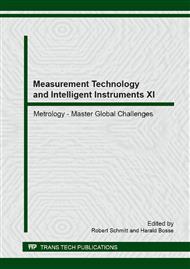p.374
p.381
p.392
p.401
p.408
p.417
p.428
p.440
p.446
Study on the Calibration of Dynamic Balancing Machine for Separating System Interference Vibration
Abstract:
The minimum achievable residual unbalance ratio emar is the index for evaluating the balancing capability of dynamic balancing machine. When the emar is expected to achieve to 0.1um grade or higher, to tap potential solely from the design of the signal conditioning circuits or the digital signal processing algorithm could not settle problems completely, equal importance should be paid on eliminating the influence of machine intrinsic interference vibration. Unfortunately, compared with much effort on the research and implementation of circuits and algorithm for unbalance signal extraction, little attention has been paid on the latter. This paper puts forward an interference vibration separation approach based on multi-point test-mass circulation calibration, to the purpose of improving the overall performance of balancing machine.The measurement system of a dynamic balancing machine composed of vibration mechanism, vibration pick-up sensor, signal conditioning circuits and the digital signal processing module, wherein the vibration mechanism locates on the front end and is of great importance. In the current design of dynamic balancing machine, there is a hypothesis that the vibration mechanism vibrates in the manner of simple harmonic oscillation forced by the unbalance of the under test rotate work piece and the amplitude and initial phase of that vibration are only related to the magnitude and angle position of the unbalance. In a practical balancing machine, however, the unbalance of driving devices, the coaxial error of the coupling or the vibration of the driving belt will incur additional vibrations to the vibration mechanism. Being of the same frequency or nearby frequency with the unbalance vibration, those interference vibrations are difficulty to remove by the signal conditioning circuits or the digital signal processing approach.Based on the invariability of the machine intrinsic interference vibration, this paper developed a circumference multi-point measurement and compound calibration method. The principle of the method will be introduced and analyzed in detail in the paper. Based on the vector operation and least square fitting to the unbalance vibration response with the obtained compound vibrations, the interference vibration can be separated to a satisfied extent. Experiments investigation is carried out on a hard bearing dynamic balancing machine, and the experiment results demonstrate the feasibility of the said method.
Info:
Periodical:
Pages:
408-414
Citation:
Online since:
May 2014
Authors:
Price:
Сopyright:
© 2014 Trans Tech Publications Ltd. All Rights Reserved
Share:
Citation:


